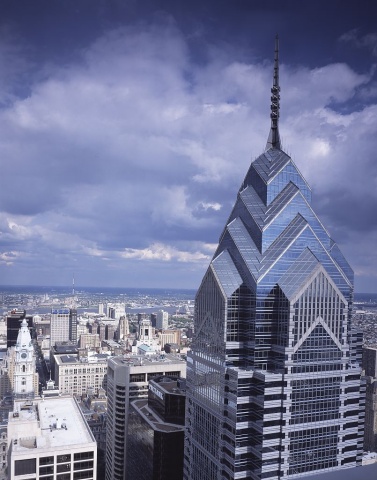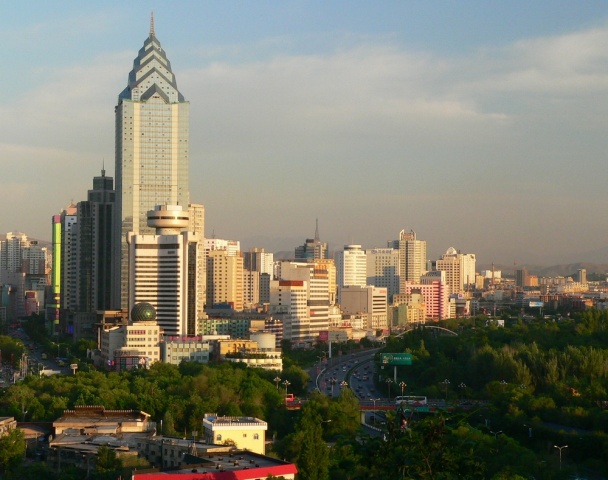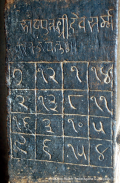Mark Dominus (陶敏修)
mjd@pobox.com

Archive:
| 2025: | JFMAMJ |
| JAS | |
| 2024: | JFMAMJ |
| JASOND | |
| 2023: | JFMAMJ |
| JASOND | |
| 2022: | JFMAMJ |
| JASOND | |
| 2021: | JFMAMJ |
| JASOND | |
| 2020: | JFMAMJ |
| JASOND | |
| 2019: | JFMAMJ |
| JASOND | |
| 2018: | JFMAMJ |
| JASOND | |
| 2017: | JFMAMJ |
| JASOND | |
| 2016: | JFMAMJ |
| JASOND | |
| 2015: | JFMAMJ |
| JASOND | |
| 2014: | JFMAMJ |
| JASOND | |
| 2013: | JFMAMJ |
| JASOND | |
| 2012: | JFMAMJ |
| JASOND | |
| 2011: | JFMAMJ |
| JASOND | |
| 2010: | JFMAMJ |
| JASOND | |
| 2009: | JFMAMJ |
| JASOND | |
| 2008: | JFMAMJ |
| JASOND | |
| 2007: | JFMAMJ |
| JASOND | |
| 2006: | JFMAMJ |
| JASOND | |
| 2005: | OND |
Subtopics:
| Mathematics | 245 |
| Programming | 99 |
| Language | 95 |
| Miscellaneous | 75 |
| Book | 50 |
| Tech | 49 |
| Etymology | 35 |
| Haskell | 33 |
| Oops | 30 |
| Unix | 27 |
| Cosmic Call | 25 |
| Math SE | 25 |
| Law | 22 |
| Physics | 21 |
| Perl | 17 |
| Biology | 16 |
| Brain | 15 |
| Calendar | 15 |
| Food | 15 |
Comments disabled
Tue, 31 Jan 2017
Below, One Liberty Place, the second-tallest building in my home city of Philadelphia. (Completed 1987, height 288 meters.)
Below, Zhongtian International Mansion at Fortune Plaza, the tallest building in Ürümqi, capital city of Xinjiang in northwest China.
(Completed 2007, height 230 meters.)
[ Addendum: Perhaps I should mention that One Liberty Place is itself widely seen as a knockoff of the much more graceful and elegant Chrysler Building in New York City. (Completed 1930, height 319 meters.) ]
[ Addendum: I brought this to the attention of GroJLart, the foulmouthed architecture blogger who knows everything, absolutely everything, about Philadelphia buildings, and he said “Thanks. I wrote an article on the same subject in 2011”. Of course. ]
[Other articles in category /misc] permanent link
Mon, 30 Jan 2017
Digit symbols in the Parshvanatha magic square
In last month's article about the magic square at the Parshvanatha temple, shown at right, I said:
It has come to my attention that the digit symbols in the magic square are not too different from the current forms of the digit symbols in the Gujarati script. The temple is not very close to Gujarat or to the area in which Gujarati is common, so I guess that the digit symbols in Indian languages have evolved in the past thousand years, with the Gujarati versions remaining closest to the ancient forms, or else perhaps Gujarati was spoken more widely a thousand years ago. I would be interested to hear about this from someone who knows.
Shreevatsa R. replied in detail, and his reply was so excellent that, finding no way to improve it by adding or taking away, I begged his permission to republish it without change, which he generously granted.
Am sending this email to say:
- Why it shouldn't be surprising if the temple had Gujarati numerals
- Why the numerals aren't Gujarati numerals :-)
The Parshvanatha temple is located in the current state of Madhya Pradesh. Here is the location of the temple within a map of the state:
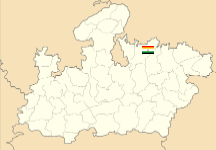
And here you can see that the above state of Madhya Pradesh (14 in the image below) is adjacent to the state of Gujarat (7):
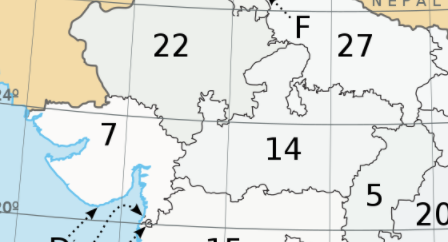
The states of India are (sort of) organized along linguistic lines, and neighbouring states often have overlap or similarities in their languages. So a priori it shouldn't be too surprising if the language is that of a neighbouring state.
But, as you rightly say, the location of the Parshvanatha temple is actually quite far from the state (7) where Gujarat is spoken; it's closer to 27 in the above map (state named Uttar Pradesh).
Well, the Parshvanatha temple is believed to have been built "during the reign of the Chandela king Dhanga", and the Chandela kings were feudatories (though just beginning to assert sovereignty at the time) of the Gurjara-Pratihara kings, and "Gurjara" is where the name of the language of "Gujarati" comes from. So it's possible that they used the "official" language of the reigning kings, as with colonies. In fact the green area of the Gurjara-Pratihara kings in this map covers the location of the Parshvanatha temple:

But actually this is not a very convincing argument, because the link between Gurjara-Pratiharas and modern Gujarati is not too strong (at least I couldn't find it in a few minutes on Wikipedia :P)
So moving on...
Are the numerals really similar to Gujarati numerals? These are the numbers 1 to 16 from your blog post, ordered according to the usual order:
















These are the numerals in a few current Indic scripts (as linked from your blog post):
Look at the first two rows above. Perhaps because of my familiarity with Devanagari, I cannot really see any big difference between the Devanagari and Gujarati symbols except for the 9: the differences are as minor as variation between fonts. (To see how much the symbols can change because of font variation, one can go to Google Fonts' Devanagari page and Google Fonts' Gujarati page and click on one of the sample texts and enter "० १ २ ३ ४ ५ ६ ७ ८ ९" and "૦ ૧ ૨ ૩ ૪ ૫ ૬ ૭ ૮ ૯" respectively, then "Apply to all fonts". Some fonts are bad, though.)
(In fact, even the Gurmukhi and Tibetan are somewhat recognizable, for someone who can read Devanagari.)
So if we decide that the Parshvanatha temple's symbols are actually closer not to modern Gujarati but to modern Devanagari (e.g. the "3" has a tail in the temple symbols which is present in Devanagari but missing in Gujarati), then the mystery disappears: Devanagari is still the script used in the state of Madhya Pradesh (and Uttar Pradesh, etc: it's the script used for Hindi, Marathi, Nepali, Sanskrit, and many other languages).
Finally, for the complete answer, we can turn to history.
The Parshvanatha temple was built during 950 to 970 CE. Languages: Modern Gujarati dates from 1800, Middle Gujarati from ~1500 to 1800, Old Gujarati from ~1100 to 1500. So the temple is older than the earliest language called "Gujarati". (Similarly, modern Hindi is even more recent.) Turning to scripts instead: see under Brahmic scripts.
- Nagari, 8th century
- Devanagari, 13th century
- Gujarati 16th century
So at the time the temple was built, neither Gujarati script nor Devanagari proper existed. The article on the Gujarati script traces its origin to the Devanagari script, which itself is a descendant of Nagari script.
At right are the symbols from the Nagari script, which I think are closer in many respects to the temple symbols.
So overall, if we trace the numerals in (a subset of) the family tree of scripts:
Brahmi > Gupta > Nagari > Devanagari > Gujarati
we'll find that the symbols of the temple are somewhere between the "Nagari" and "Devanagari" forms. (Most of the temple digits are the same as in the "Nagari" example above, except for the 5 which is closer to the Devanagari form.)
BTW, your post was about the numerals, but from being able to read modern Devanagari, I can also read some of the words above the square: the first line ends with ".. putra śrī devasarmma" (...पुत्र श्री देवसर्म्म) (Devasharma, son of...), and these words have the top bar which is missing in Gujarati script.
[Other articles in category /lang] permanent link



